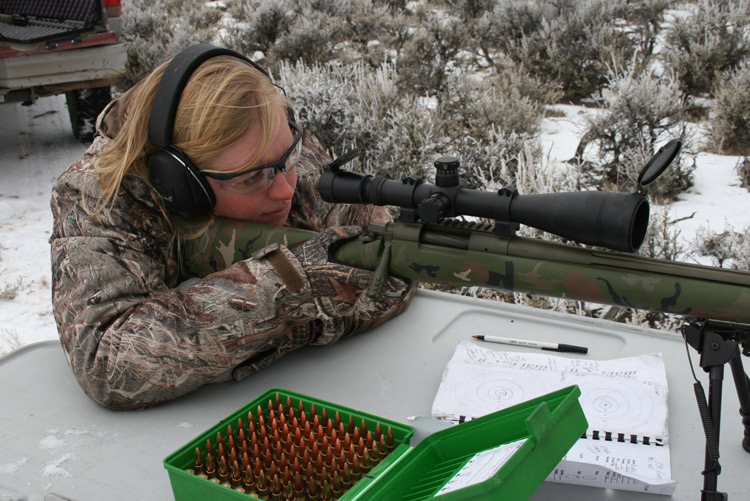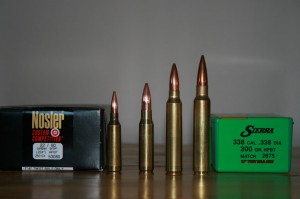

One of the things I really like about long-range shooting is the challenge of getting everything just right over and over for consistent precise hits way out there. Although the definition of long range changes every year, 1,000 yards is still a good poke even with rifles that are capable of consistent extreme long-range accuracy. To become a reliable long-distance shooter, capable of striking your target every time, a shooter must first learn to handle several key challenges.
1. Distance
Accurately determining the distance to a target and properly adjusting the elevation of the shot is the first thing a shooter must be able to address. As a bullet leaves a barrel, it’s immediately acted upon by gravity pulling it toward earth. As it gets farther from the barrel, it gets closer to the ground. When a rifle is sighted at 100 yards, the bullet will pass through the point of aim (POA), which is where the crosshairs and bullet intersect at the target. As the bullet continues past that point it will continue to drop at a repeatable rate. This can be calculated for any given yardage and must be adjusted with the turret of the scope or using the hash marks on some reticles to adjust for the bullet’s drop at the distance the target is situated.
2. Environmental Conditions
Environmental conditions will also definitely affect bullet performance. As a set of general rules, warm air tends to be thinner than cold air meaning a bullet in warm air will meet less resistance. Heat can also adversely affect the barrel temperature with each additional shot, which can affect bullet flight after it travels down the barrel. Although many people assume humid air is denser, dry air molecules are actually heavier than water molecules meaning less humidity can actually negatively impact bullet flight more. Likewise, thinner air at higher elevations or with decreased barometric pressure will impede bullet flight less.
3. Wind
Wind is perhaps one of the biggest obstacles a long-distance shooter must contend with and can be trickier than elevation. The challenge to wind is there are two calculations: Estimating its speed and estimating the correction. A wind meter provides the shooter a precise way to estimate wind. Other signs at the target have to be observed to confirm what the wind is doing where the bullet will travel. Direction of the wind also is important. Obviously which way the wind is going will indicate which way the bullet will drift but also important is the angle that the wind is contacting the bullet. Direct wind at 90 degrees to the bullet path will have the most effect. Wind from 10-15 degrees of either side of the 12 o’clock or six o’clock areas will have no value or no appreciable effect on the bullet flight. Wind striking the bullet at a 45 degree angle to the bullet path will have a half value or will affect the bullet flight half as much as a full value.
4. Inclination
Another overlooked obstacle, at least until you miss a trophy animal because of it, is inclination. Inclination is the up or down angle the shot is taken at. In general shots will print high whether a shot is taken at a steep up or down angle. This is because the line of sight that the range is estimated at is different than the actual distance the bullet is affected by gravity. The amount of up or down can be calculated using the amount of angle and the distance. At shorter hunting distances on a big boiler room this can be quickly addressed by holding off a little low but for more precise compensation such as a sniper making a high angle shot at 100 yards or better is should be figured into the shot.

5. Cartridge Performance
Cartridge performance also comes into play when estimating range correction or calculating adjustments in your aim in order to contend with the many factors that may affect your shot. Cartridge velocity must be consistent from shot to shot with the selected bullet so that corrections will also be precisely the same every time the scope or aim is adjusted. Quality match ammo or reloads must be tested for consistency in velocity and performance. The shooter must become comfortable with the rifle and ammo and confident in its consistency. Avoid using inferior or bargain ammo as it may not perform as consistently throwing calculations off and resulting in seriously blown shots at long-range.
This article appeared in the April 8, 2013 issue of Gun Digest the Magazine.

Next Step: Get your FREE Printable Target Pack
Enhance your shooting precision with our 62 MOA Targets, perfect for rifles and handguns. Crafted in collaboration with Storm Tactical for accuracy and versatility.
Subscribe to the Gun Digest email newsletter and get your downloadable target pack sent straight to your inbox. Stay updated with the latest firearms info in the industry.

![Best Concealed Carry Guns In 2025 [Field Tested] Wilson Combat EDC X9S 1](https://gundigest.com/wp-content/uploads/Wilson-Combat-EDC-X9S-1-324x160.jpg)


![Best 9mm Carbine: Affordable PCCs [Tested] Ruger Carbine Shooting](https://gundigest.com/wp-content/uploads/Ruger-Carbine-Shooting-100x70.jpg)
![Best AR-15: Top Options Available Today [Field Tested] Harrington and Richardson PSA XM177E2 feature](https://gundigest.com/wp-content/uploads/Harrington-and-Richardson-PSA-XM177E2-feature-100x70.jpg)

Or you could just buy a TrackingPoint smart rifle.